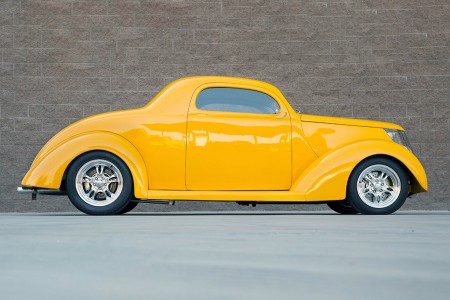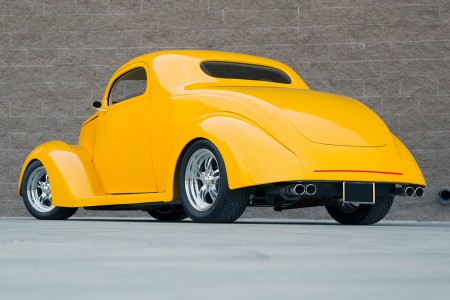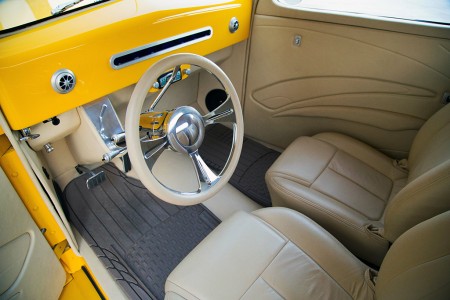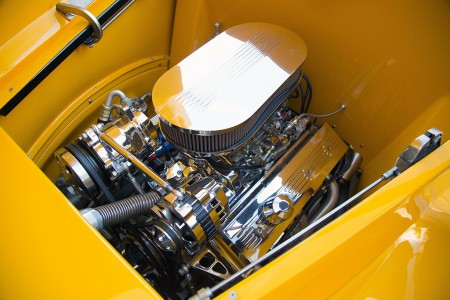
Image: Front 3/4 image showing the front and side of the vehicle simultaneously.
How to take great photos
We have all heard the expression “a picture is worth a thousand words,” right? Many sellers often overlook the importance of photographs when selling a vehicle. While hiring a professional photographer or using professional equipment to capture images of your vehicle is highly recommended, it’s not practical for everyone. If you do hire a professional, make sure you understand your usage rights and get a release. Here are some great tips for taking photos of the vehicle:
1. Make sure the car ( exterior, interior and engine) is clean (remove license plate).
2. Make sure to photograph both sides of the vehice.
3. Photograph outside in good light (unless in a studio).
4. Get close, but not too close to cut parts of the car off.
5. Make sure the car is the focus (no clutter, people or distractions in the car or background)

Side profile image of the car.
LOCATION. While the rear of a supermarket, department store or warehouse may not sound like the prettiest location, it offers fewer background distractions than areas where you would see a driveway, grass or snow and pavement with parking lines and debris. Think “blank canvas,” your goal is to market and sell your car, not to create an artistic masterpiece.
When scouting a location, find a space without trees, poles or signs in the background so that while you are photographing your vehicle, you will only need to watch for people, animals or reflections in the photo.
REFLECTIONS. Be aware of unwanted reflections in that beautifully detailed paint job. Keep an eye out for reflections of yourself, parking lines, poles and other cars. Finding a minimal or zero reflection scenario might be difficult, depending on your vehicle’s body lines.

Rear 3/4 image showing the rear and side of the vehicle simultaneously.
LIGHT. Outdoors in the open shade is best for even lighting and reflection reduction. After selecting a location, feel free to check it out at your desired photographing time to ensure it is not busy and verify that the lighting will work. If you can’t find any open shade, don’t worry – wait for the “magic hour” just before sunset or get up early the next day to catch the sunrise.
Even lighting is also crucial for photos of the engine and interior. Do not use flash and avoid shooting indoors or in low-light scenarios where blurriness and loss of detail can occur.
REQUIRED IMAGES. Once you start taking photos, remember you need a minimum of six photos, one showing the Vehicle Identification Number, or VIN, a shot of the interior, the engine, a side profile and the two most essential angles: the front 3/4 and rear 3/4. A driver’s side front 3/4 is the money shot!
A front 3/4 image refers to the angle showing the front and side of the vehicle simultaneously, not just three-quarters of the car. Similarly, a rear 3/4 image refers to the opposite side showing the rear and side of the vehicle simultaneously.
To capture your vehicle’s best “stance,” hold your phone/camera at a lower angle, 2 to 3 feet off the ground.
Other images are also welcome: details, direct front and direct rear, and current odometer reading among others.

Interior image.
TAKING THE PHOTOS. Most importantly, make sure your phone’s camera lens is clean. It won’t matter how much preparation you put into your photos if you have a huge smudge on the lens. (Or your own thumb in the shot)
Like the iPhone, most phones have multiple lenses designed to do different things. The iPhone 13 Pro is equipped with a telephoto lens, a wide lens and an ultra-wide lens for up-close macro photography. The Samsung S22 Ultra utilizes a wide lens, an ultra-wide lens, a telephoto lens and a super-telephoto lens.
This means you won’t have much control over what lens the phone has decided to use while using the native camera app when you are up close.
On an iPhone, you will want to make sure your photo ratio is 4:3. To do this, click the arrow at the top center of the screen on the camera app; a menu will appear at the bottom, and on the right will be the photo ratio. Options include square, 4:3 and 16:9. You will also want to make sure Live and the flash are toggled to off.
To get the least distorted image, utilize your phone’s telephoto lens. To do this, select the “3x” zoom option and back up. To capture the engine and interior you will want to utilize your phone’s wide lens abilities.
Be sure to hold your phone in landscape (horizontal) mode. Ensure there is plenty of room around your vehicle when you capture the image – do not cut off any parts of the car – it is better to have plenty of space above, below and to the sides of the vehicle in your image. Enabling the gridlines under composition in the camera settings will also help you make sure you are capturing a level image, as it puts faint gridlines over what you are viewing on the screen to help guide you and prevent a crooked image. Don’t worry, it won’t apply the gridlines to the final image.
While shooting, make sure to take multiple photos at different angles – sometimes a step or two over can make or break your shot and it’s better to have too many photos to choose from than not enough.

Engine image.
SENDING IMAGES. Original-size photos from the phone camera are necessary for the best quality. Do not reduce or resize in any way. Keep them as high-resolution as possible.
TRY AGAIN. We know this sounds like simple stuff for the most part. However, when you are out shooting in an unfamiliar place with your precious car, it is easy to forget even the most essential things – especially when shooting on a whim without any preparation.
If you notice any glaring issues when reviewing your images, like a bad reflection or if the pavement cracks you didn’t think were a big deal suddenly make it look like you parked across the Grand Canyon, try again.
Remember, these photos play a significant role in marketing and selling your vehicles. Take the time to do it right and consider what you would want to see if you were thinking of purchasing the car – this is your vehicle’s time to shine!
Click here to some other helpful articles for taking great photos.
Photos and body of the article shared courtesy of Barrett-Jackson, with additional insights and tips added!